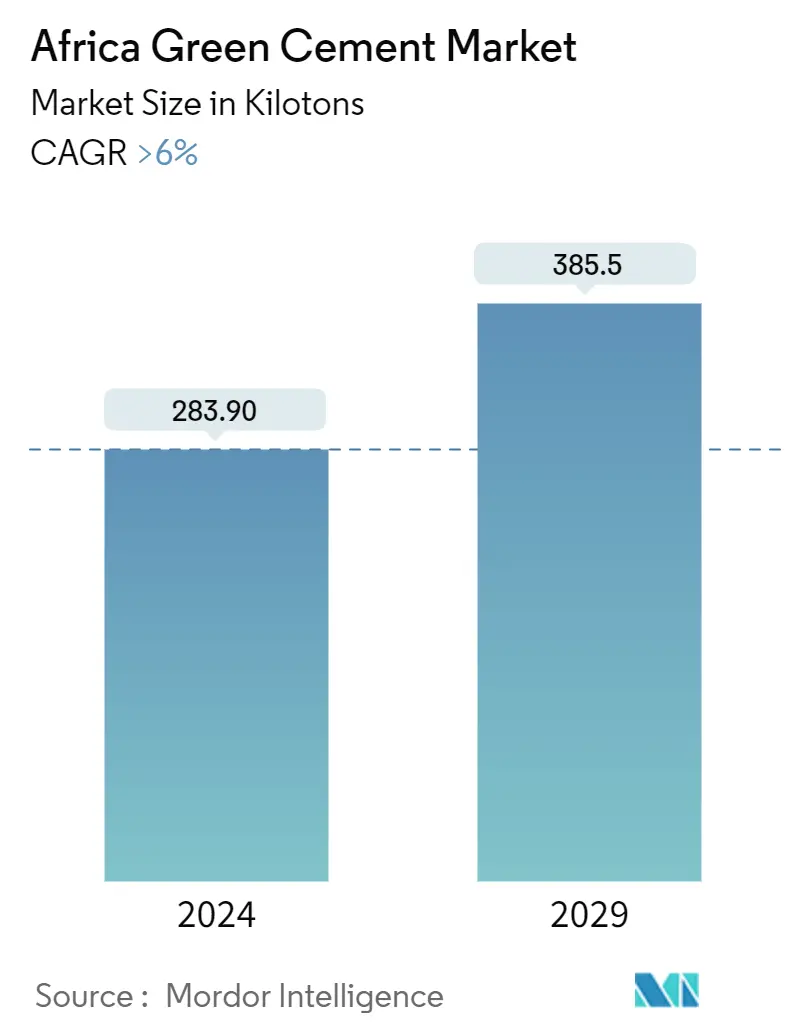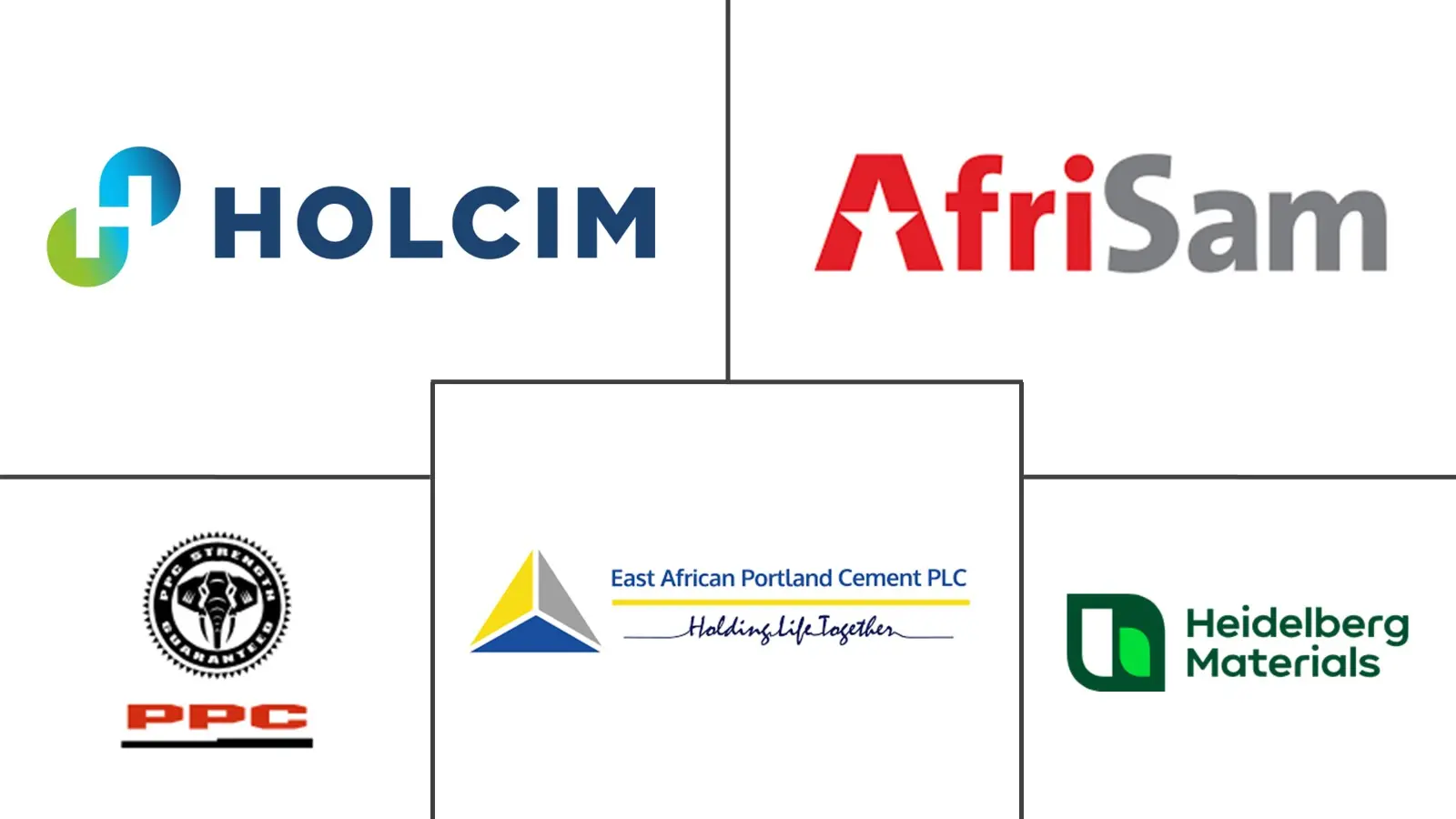Market Size of Africa Green Cement Industry

| Study Period | 2019-2029 |
| Base Year For Estimation | 2023 |
| Market Volume (2024) | 283.90 kilotons |
| Market Volume (2029) | 385.5 kilotons |
| CAGR (2024 - 2029) | > 6.00 % |
| Market Concentration | Medium |
Major Players
*Disclaimer: Major Players sorted in no particular order |
Africa Green Cement Market Analysis
The Africa Green Cement Market size is estimated at 283.90 kilotons in 2024, and is expected to reach 385.5 kilotons by 2029, growing at a CAGR of greater than 6% during the forecast period (2024-2029).
The outbreak of the COVID-19 pandemic in 2020 slowed construction and building activities in Africa, leading to decreased demand for green cement. The pandemic made the governments impose travel restrictions and other regulations that caused challenges such as disruption in the supply chain and low demand. However, the conditions started recovering in 2021, restoring the market's growth.
Over the short term, growing construction projects in major African economies like South Africa and Egypt, favorable government policies for the usage of green cement, and availability of raw materials are major factors driving the growth of the market studied.
However, the lack of awareness of the use of green cement and the rising cost of construction is likely to restrain the growth of the studied market.
Nevertheless, research and development of novel products as raw materials for green cement will likely create lucrative growth opportunities for the global market.
South Africa represents the largest market over the forecast period due to the increasing adoption of green cement in its construction projects.
Africa Green Cement Industry Segmentation
Green cement is an environmentally friendly cement that reduces carbon dioxide emissions during manufacturing. Green cement is mostly produced from raw materials that are discarded as waste from industrial processes. Some of the major raw materials for producing green cement include the slag from the blast furnace and fly ash. Magnesium oxychloride cement, calcium sulfoaluminate cement, geopolymer cement, and sequestrated carbon cement are some examples of green cement.
Africa's green cement market is segmented by product type, construction sector, and geography. By product type, the market is segmented into fly ash-based, slag-based, limestone-based, silica fume-based, and other product types (geopolymers and recycled aggregates). By the construction sector, the market is segmented into residential and non-residential. The report also covers the market size and forecasts for the African green cement market in 4 countries across the African region.
For each segment, the market sizing and forecasts have been done on the basis of volume (tons).
| Product Type | |
| Fly Ash-based | |
| Slag-based | |
| Limestone-based | |
| Silica fume-based | |
| Other Product Types (Geopolymers and Recycled Aggregates) |
| Construction Sector | |
| Residential | |
| Non-residential |
| Geography | |
| South Africa | |
| Egypt | |
| Algeria | |
| Nigeria | |
| Rest of Africa |
Africa Green Cement Market Size Summary
The African green cement market is poised for significant growth, driven by increasing construction activities and favorable government policies across major economies such as South Africa and Egypt. The market, which experienced a slowdown due to the COVID-19 pandemic, is recovering as demand for eco-friendly construction materials rises. Green cement is gaining popularity for its environmental benefits, including reduced carbon emissions and energy consumption, making it a preferred choice for green building projects. The market's expansion is supported by the availability of raw materials and ongoing research and development efforts to innovate new products. However, challenges such as limited awareness and rising construction costs may hinder growth.
South Africa stands out as the largest market for green cement in Africa, with several local producers like Lafarge, PPC Cement, and Afrisam South Africa leading the charge. The country's construction sector is witnessing a surge in both residential and commercial projects, bolstered by investments and partnerships aimed at enhancing energy efficiency. Initiatives such as the International Finance Corporation's funding for green building projects and collaborations with international organizations like the Carbon Trust underscore the positive outlook for green cement in South Africa. The market is partially consolidated, with key players actively expanding their operations and introducing new products to meet the growing demand for sustainable construction solutions across the continent.
Africa Green Cement Market Size - Table of Contents
-
1. MARKET DYNAMICS
-
1.1 Drivers
-
1.1.1 Growing Construction Activities in Africa
-
1.1.2 Favorable Government Policies for Green Building Construction
-
1.1.3 Abundance of Availability of Raw Materials
-
-
1.2 Restraints
-
1.2.1 Lack of Awareness Regarding Green Cement
-
1.2.2 Rising Construction Costs
-
-
1.3 Industry Value Chain Analysis
-
1.4 Porter's Five Forces Analysis
-
1.4.1 Bargaining Power of Suppliers
-
1.4.2 Bargaining Power of Buyers
-
1.4.3 Threat of New Entrants
-
1.4.4 Threat of Substitute Products and Services
-
1.4.5 Degree of Competition
-
-
-
2. MARKET SEGMENTATION (Market Size in Volume)
-
2.1 Product Type
-
2.1.1 Fly Ash-based
-
2.1.2 Slag-based
-
2.1.3 Limestone-based
-
2.1.4 Silica fume-based
-
2.1.5 Other Product Types (Geopolymers and Recycled Aggregates)
-
-
2.2 Construction Sector
-
2.2.1 Residential
-
2.2.2 Non-residential
-
-
2.3 Geography
-
2.3.1 South Africa
-
2.3.2 Egypt
-
2.3.3 Algeria
-
2.3.4 Nigeria
-
2.3.5 Rest of Africa
-
-
Africa Green Cement Market Size FAQs
How big is the Africa Green Cement Market?
The Africa Green Cement Market size is expected to reach 283.90 kilotons in 2024 and grow at a CAGR of greater than 6% to reach 385.5 kilotons by 2029.
What is the current Africa Green Cement Market size?
In 2024, the Africa Green Cement Market size is expected to reach 283.90 kilotons.

